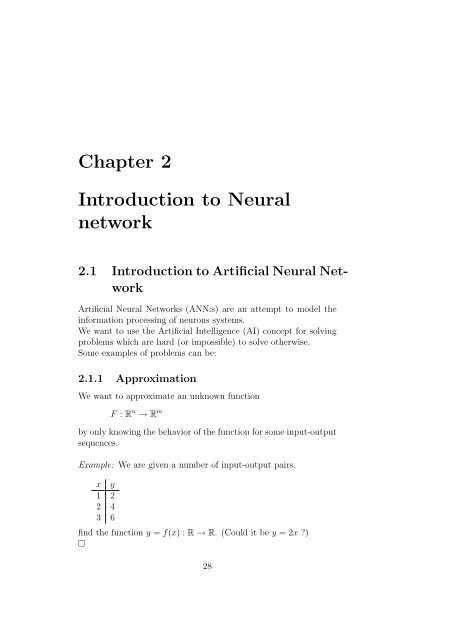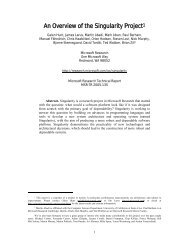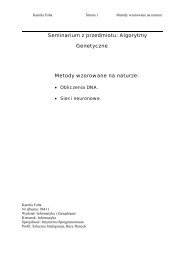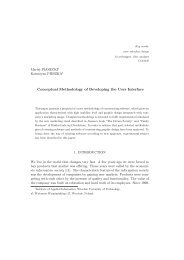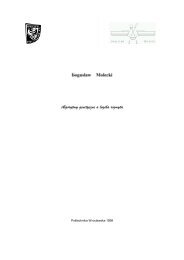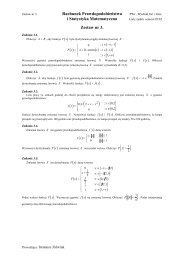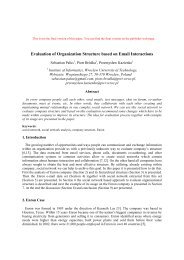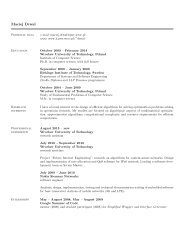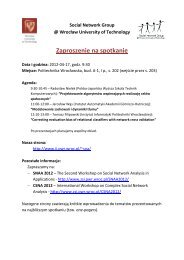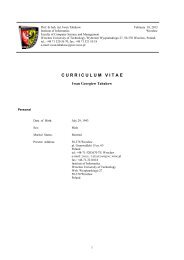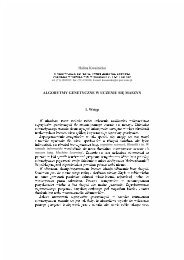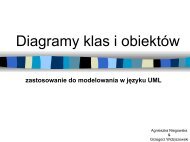Chapter 2 Introduction to Neural network
Chapter 2 Introduction to Neural network
Chapter 2 Introduction to Neural network
You also want an ePaper? Increase the reach of your titles
YUMPU automatically turns print PDFs into web optimized ePapers that Google loves.
<strong>Chapter</strong> 2<br />
<strong>Introduction</strong> <strong>to</strong> <strong>Neural</strong><br />
<strong>network</strong><br />
2.1 <strong>Introduction</strong> <strong>to</strong> Artificial <strong>Neural</strong> Network<br />
Artificial <strong>Neural</strong> Networks (ANN:s) are an attempt <strong>to</strong> model the<br />
information processing of neurons systems.<br />
We want <strong>to</strong> use the Artificial Intelligence (AI) concept for solving<br />
problems which are hard (or impossible) <strong>to</strong> solve otherwise.<br />
Some examples of problems can be:<br />
2.1.1 Approximation<br />
We want <strong>to</strong> approximate an unknown function<br />
F : R n → R m<br />
by only knowing the behavior of the function for some input-output<br />
sequences.<br />
Example: We are given a number of input-output pairs.<br />
x y<br />
1 2<br />
2 4<br />
3 6<br />
find the function y = f(x) : R → R. (Could it be y = 2x )<br />
□<br />
28
Example:<br />
¡<br />
Many signal processing problems can be transformed <strong>to</strong> the approximation<br />
problem. We will deal with arbitrary number of input<br />
and output for any nonlinear function.<br />
2.1.2 Association<br />
The ideas is <strong>to</strong> put a finite number of items in memory (e.g. the<br />
Latin characters) and by presenting dis<strong>to</strong>rted versions, we want the<br />
item <strong>to</strong> be res<strong>to</strong>red.<br />
Example:<br />
Input<br />
Output<br />
¡<br />
□<br />
2.1.3 Pattern classification<br />
A number of inputs should be classified in<strong>to</strong> categories.<br />
o<br />
¡<br />
90 C OK<br />
o<br />
100 C<br />
Error<br />
□<br />
2.1.4 Prediction<br />
Given information up <strong>to</strong> present time predict the behavior in the<br />
future.<br />
2.1.5 Au<strong>to</strong>matic control (Reglerteknik)<br />
We want <strong>to</strong> simulate the behavior of a process so that we can control<br />
it <strong>to</strong> fit our purposes.<br />
29
¡¢£¤¡¢£¥ ¡ ¢£¦ § ¡¢£¤§¡¢£¥ § ¡¢£¦<br />
¤¥¤¦ ¤ §¨¥¨¦¨§ ©<br />
2.1.6 Beamforming<br />
We want <strong>to</strong> create directional hearing by the use of multiple sensors.<br />
The model<br />
Regard the ANN as a mapping box. An input x gives an output y<br />
The box can be feed forward (i.e. no recursions) or a recurrent<br />
(with recursion) <strong>network</strong>. The complexity of its interior can vary<br />
depending on the task.<br />
The box have parameters (weights) which can be modified <strong>to</strong> suite<br />
different tasks.<br />
2.2 A Neuron model<br />
Given an input signal x it create a single output value<br />
where y = f(x T w), f : R → R, f ⊂ C 1 , any function. The vec<strong>to</strong>r<br />
w = [w 1 w 2 · · · w n ] T is called the weights of the neuron. Often<br />
w ∈ R n .<br />
¢ ¡¢£<br />
30
¡¢¡<br />
¥¦¡¥¦¡¥¦¡<br />
¡ ¤ ¢ £<br />
£<br />
2.3 A feedforward Network of Neurons<br />
(3-layers)<br />
[1]<br />
[1]<br />
[2] ¤ ¡¤¢¡ ¥§<br />
[2]<br />
[3]<br />
[3]<br />
[1]<br />
¦¡¦¢¦¥<br />
[2]<br />
¨¢<br />
[3]<br />
¡¢©<br />
Input<br />
layer<br />
First hidden<br />
layer<br />
Second hidden<br />
layer<br />
output<br />
layer<br />
[ [ [ ]] ]<br />
⇔ y = H W [3] · G W [2] · F W [1] · x<br />
¤ ¡¤¢¡ £¥<br />
¤ ¡¤¢¡ §© ¨¡¨§© ¡ ¢ ¡¢£<br />
where<br />
F = [f 1 f 2 · · · f m ] T , G = [g 1 g 2 · · · g k ] T , H = [h 1 h 2 · · · h i ] T<br />
and<br />
W [1] = [w [1]<br />
ij ] m×n, W [2] = [w [2]<br />
ij ] k×m, W [3] = [w [3]<br />
ij ] i×k<br />
2.4 A recurrent Network<br />
Z −1 -delay opera<strong>to</strong>r. ”The Hopfield Network”<br />
31
2.5 Learning<br />
Depending on the task <strong>to</strong> solve different learning paradigms (strategies)<br />
are used.<br />
Learning<br />
Unsupervised<br />
Supervised<br />
Reinforced learning<br />
Corrective learning<br />
Supervised - during learning we tell the ANN what we want as<br />
output (desired output).<br />
corrective learning - desired signals are realvalued<br />
reinforced learning - desired signals are true/false<br />
Unsupervised - Only input signals are available <strong>to</strong> the ANN during<br />
learning (e.g. signal separation)<br />
One drawback with learning system are that it is <strong>to</strong>tally lost when<br />
facing a scenario which it has never faced during training.<br />
32
¢¥¢¦ ¢ §¨¥¨¦¨§ ©<br />
<strong>Chapter</strong> 3<br />
Threshold logic<br />
These units are neurons where the function is a shifted step function<br />
and where the inputs are Boolean numbers (1/0). All weights are<br />
equal <strong>to</strong> ±1<br />
y =<br />
{ 1 if x T w θ<br />
0 if x T w < θ<br />
¡¢£θ¤<br />
¡¢£θ¤¥<br />
θ<br />
¢<br />
Proposition All logical functions can be implemented with a <strong>network</strong><br />
of these units, since they can implement, AND, OR and NOT<br />
function.<br />
33
3.1 Hadamard-Walsh transform<br />
For bipolar coding (-1/1) the Hadamard-Walsh transform converts<br />
every Boolean function of n variables in<strong>to</strong> a sum of 2 n products.<br />
Example:<br />
X 1 X 2 X 1 OR X 2<br />
−1 −1 −1 f 1<br />
−1 1 1 f 2<br />
1 −1 1 f 3<br />
1 1 1 f 4<br />
The hadamard-Walsh matrix H n is defined recursively as<br />
H n = 1 [ ]<br />
Hn−1 H n−1<br />
2 −H n−1 H n−1<br />
whereby<br />
H 1 = 1 2<br />
[ 1 1<br />
−1 1<br />
]<br />
each row/column in the matrix are orthogonal <strong>to</strong> the other rows/columns.<br />
We want <strong>to</strong> find the coefficients a which solve the equation<br />
by using<br />
⎡<br />
X 1 ORX 2 = 1 4 (a 1 + a 2 x + a 3 x 2 + a 4 x 1 x } {{ } 2 )<br />
no. 2 2<br />
⎢<br />
⎣<br />
⎡<br />
⎢<br />
⎣<br />
which gives<br />
□<br />
a 1<br />
a 2<br />
.<br />
a 2 n<br />
⎤<br />
⎤<br />
a 1<br />
a 2<br />
a 3<br />
a 4<br />
⎡<br />
⎥<br />
⎦ = H n ⎢<br />
⎣<br />
⎥<br />
⎦ = 1 4<br />
⎡<br />
⎢<br />
⎣<br />
f 1<br />
f 2<br />
.<br />
f 2 n<br />
⎤<br />
⎥<br />
⎦<br />
1 1 1 1<br />
−1 1 −1 1<br />
−1 −1 1 1<br />
1 −1 −1 1<br />
⎤ ⎡<br />
⎥ ⎢<br />
⎦ ⎣<br />
X 1 ORX 2 = 1 4 (2 + 2x 1 + 2x 2 − 2x 1 x 2 )<br />
34<br />
−1<br />
1<br />
1<br />
1<br />
⎤<br />
⎥<br />
⎦
¢¥¢¦ ¢ §¨¥¨¦¨§ ©<br />
<strong>Chapter</strong> 4<br />
The Perceptron<br />
The perceptron is a weighted threshold logic unit.<br />
y =<br />
{ 1 if x T w θ<br />
0 if x T w < θ<br />
¡¢£θ¤<br />
x, w ∈ R n<br />
The perceptron can classify all input vec<strong>to</strong>rs belonging <strong>to</strong> linearly<br />
separable classes.<br />
Example:<br />
P and N are linear separable!<br />
□<br />
¢£¤¥¦§ £ ¤¥¦¨ ©£ ¡<br />
35
¢£¤¥¦§ £ ¤¥¦¨<br />
¢¥¢¦§¡¢£¤¡¢ ¨©¢£¡£ ¡¢£ ¦£<br />
¡¢£¢¡¡¦£<br />
Example:<br />
Not linear separable!<br />
□<br />
Example: Classification problem<br />
©£ ¡<br />
□<br />
¢ ¥¢¦§<br />
¡¢£¤¡¢<br />
4.1 Perceptron training<br />
¢££¦¢<br />
Assume we have sampled the sensors when the process is OK (P)<br />
as well as when its broken (N). We have a number of input vec<strong>to</strong>rs<br />
in each class.<br />
Start: Choose w 0 randomly, t = 0<br />
test: Select a vec<strong>to</strong>r x ∈ P ∪ N<br />
If all x correct, s<strong>to</strong>p!<br />
36
⎧<br />
⎪⎨<br />
⎪⎩<br />
if x ∈ P and x T w t > 0 go<strong>to</strong> test<br />
if x ∈ P and x T w t 0 go<strong>to</strong> add<br />
if x ∈ N and x T w t < 0 go<strong>to</strong> test<br />
if x ∈ N and x T w t 0 go<strong>to</strong> subtract<br />
add: 1. w t+1 = w t + x or<br />
w t+1 = w t − (xT w t−ε)<br />
x , ε > 0<br />
‖x‖ 2 2<br />
2. t = t + 1<br />
subtract: 1. w t+1 = w t − x or<br />
w t+1 = w t − (xT w t +ε)<br />
x , ε > 0<br />
‖x‖ 2 2<br />
2. t = t + 1<br />
If the two sets N and P are not perfectly linear separable we want<br />
<strong>to</strong> make a good approximation of the classification.<br />
The pocket algorithm:<br />
start: Initialize w 0 randomly<br />
define the best weight vec<strong>to</strong>r w s = w<br />
define h s = 0<br />
iterate: Update w as before<br />
Count the number h of consecutively correctly classifications.<br />
If h > h s , set w s = w and h s = h.<br />
Continue iterating.<br />
37
¡ ¢£ ¤¡¤¢¤£¥¦w x<br />
4.2 The Linear Neuron (LMS-algorithm)<br />
Is a neuron with a linear function<br />
Assume we have a signal x(n) which we want <strong>to</strong> transform linearly<br />
and match a signal d(n)<br />
¡<br />
x<br />
¢£ ¤¡¤¢¤£¥¦w x<br />
TDL L<br />
We form the error signal e(n) = d(n) − y(n). We define the instantaneous<br />
error function<br />
§<br />
J = 1 2 e(n)2<br />
We want <strong>to</strong> minimize J. we use the steepest descent approach and<br />
calculate ∇ w J<br />
∇ w J = ∇ w<br />
1<br />
2 (d(n) − wT x(n)) 2<br />
Used the chain rule and the equation become<br />
∇ w J = (d(n) − w T x(n)) · (−x(n)) = −e(n) · x(n)<br />
where the −x(n) is the inner derivative. The steepest descent states<br />
w k+1 = w k − α∇ w J<br />
w k+1 = w k + αe(n) · x(n)<br />
(LMS-algorithm)<br />
38
<strong>Chapter</strong> 5<br />
Layered Networks of<br />
perceptrons<br />
We have seen that a single perceptron can separate 2 linearly separable<br />
classes. If we put several perceptrons in a multilayer <strong>network</strong><br />
what’s the maximum number of classification regions, i.e. what’s<br />
the capacity of the <strong>network</strong> <br />
Proposition Let R(m, n) denote the number of regions bounded<br />
by m hyper-planes (of dim. n − 1) in a n-dimensional space(all<br />
hyperplane are going through origin), then<br />
where<br />
Example:<br />
R(m, n) = R(m − 1, n) + R(m − 1, n − 1)<br />
R(1, n) = 2 , n 1<br />
R(m, 0) = 0 , ∀m 1<br />
(fig 6.20) R(m, n) is computed recursively.<br />
M\N 0 1 2 3 4 5 6<br />
1 0 2 2 2 2 2 2<br />
2 0 2 4 4 4 4 4<br />
3 0 2 6 8 8 8 8<br />
4 0 2 8 14 16 16 16<br />
5 0 2 10 22 30 32 32<br />
6 0 2 12 32 52 62 64<br />
39
□<br />
A formula for R(m, n)<br />
∑n−1<br />
( ) m − 1<br />
R(m, n) = 2<br />
i<br />
i=0<br />
For a <strong>network</strong> with 3 hidden units with structure n−k −l −m that<br />
is, n input nodes k first hidden nodes, l second hidden nodes and<br />
m output nodes we get<br />
max # regions = min{R(k, n), R(l, k), R(m, l)}<br />
Example: Structure 3-4-2-3<br />
Input<br />
layer<br />
First hidden<br />
layer<br />
Second hidden<br />
layer<br />
output<br />
layer<br />
The maximum of regions in 3-dimensional input space classifiable<br />
by the <strong>network</strong> is<br />
min{R(4, 3), R(2, 4), R(3, 2)} = min(14, 4, 6) = 4<br />
That is the second hidden layer limits the performance ⇒ often the<br />
hidden layers contain more units than the input and output layers.<br />
40
¡¢£¤¥¦<br />
¦ ¢<br />
<strong>Chapter</strong> 6<br />
The backpropagation<br />
algorithm<br />
Learning of a single neuron. Consider the following model of a neuron<br />
¢w x+θ<br />
¤¥¦§¤¨©¥©§©¨ ¡¢£<br />
<br />
θ is a scalar parameter called the ”bias”. This bias gives the neuron<br />
the possibility of shifting the function f(·) <strong>to</strong> the left or right<br />
(positive or negative bias)<br />
θ<br />
Example: f(x + θ) = sign(x + θ)<br />
¡ ¢§¤¥ ¢<br />
¦θ=¤<br />
We can use the same terminology as before by defining the extended<br />
input vec<strong>to</strong>r ¯x = [x<br />
θ=£¤<br />
1 x 2 · · · x n 1] T and the extended weight<br />
vec<strong>to</strong>r ¯w = [w 1 w 2 · · · w n θ] T ⇒ y = f( ¯w T ¯x)<br />
41
Assume that we have a sequence of input vec<strong>to</strong>rs and a corresponding<br />
sequence of target (desired) scalars<br />
(¯x 1 , t 1 ), (¯x 2 , t 2 ), , · · · , (¯x N , t N )<br />
We wish <strong>to</strong> find the weights of a neuron with a non-linear function<br />
f(·) so that we can minimize the squared difference between the<br />
output y n and the target t n , i.e.<br />
min E n = min 1 2 (t n − y n ) 2 = min 1 2 e2 n<br />
, n = 1, 2, · · · , N<br />
We will use the steepest descent approach<br />
¯w (n+1) = ¯w (n) − α∇ w E<br />
We need <strong>to</strong> find ∇ w E!<br />
1<br />
∇ w E n = ∇ w<br />
2 (t n − f( ¯w T ¯x } {{ n ) }<br />
u<br />
} {{ }<br />
f(u)<br />
} {{ }<br />
h(f)<br />
) 2<br />
} {{ }<br />
g(h)<br />
The chain-rule gives ∇ w g(h(f(u))) = ∇ h g∇ f h∇ u f∇ w u<br />
∇ h g = e n<br />
∇ f h = t n − f(u) = −1<br />
∇ u f = depends on the nonlinearity f(·) we choose<br />
∇ w u = ¯x n<br />
⇒ ¯w (n+1) = ¯w (n) + αe n ∇ u f¯x n<br />
since f(·) is a function f : R → R, i.e. one-dimensional. We can<br />
write ∇ u f = df<br />
du<br />
⇒ The neuron learning rule for general function f(·) is<br />
¯w (n+1) = ¯w (n) + αe n<br />
df<br />
du¯x n<br />
Where u = ¯w T ¯x and α is the stepsize.<br />
OBS! If f(u) = u, that is a linear function with slope 1, the above<br />
algorithm will become the LMS alg. for a linear neuron.<br />
( df<br />
du = 1 )<br />
42
6.1 The non-linearity of the neuron<br />
Any differentiable function f(·) can be used in the neuron. We will<br />
use 2 different functions, bi- and unipolar sigmoid function.<br />
6.1.1 The bipolar sigmoid function<br />
(the tangent hyperbolic)<br />
f(u) = tanh(γu) = 1 − e−2γu<br />
1 + e −2γu<br />
γ is called the slope (γ ∈ R)<br />
Example:<br />
tanh(γu)<br />
1.5<br />
1<br />
γ = 2<br />
γ = 1<br />
0.5<br />
γ = 0.25<br />
0<br />
0.5<br />
1<br />
1.5<br />
6 4 2 0 2 4 6<br />
u<br />
often γ = 1.<br />
The derivative of f(u) is<br />
df<br />
du = γ(1 − tanh(γu)2 ) = γ(1 − f(u) 2 )<br />
43
6.1.2 The unipolar sigmoid function<br />
Example:<br />
f(u) =<br />
1<br />
1 + e −γu<br />
f(u)<br />
1.2<br />
1<br />
γ = 2<br />
0.8<br />
γ = 1<br />
0.6<br />
γ = 0.25<br />
0.4<br />
0.2<br />
0<br />
0.2<br />
6 4 2 0 2 4 6<br />
u<br />
The derivative of f(u) is<br />
(<br />
)<br />
df<br />
du = γ 1<br />
1<br />
1 − = γf(u)(1 − f(u))<br />
1 + e −γu 1 + e −γu<br />
this gives the update formulas for the neuron<br />
1. bipolar<br />
¯w (n+1) = ¯w (n) − αγe n (1 − y 2 n)¯x n<br />
y n = f(u n ) = tanh(γu n ) = tanh(γ ¯w T n ¯x n )<br />
2. unipolar<br />
¯w (n+1) = ¯w (n) − αγe n y n (1 − y n )¯x n<br />
y n = f(u n ) = 1<br />
1+e γu n<br />
=<br />
1<br />
1+e γ ¯wT n ¯xn<br />
44
6.2 The backpropagation algorithm for<br />
a 3-layer <strong>network</strong><br />
[1] ©¥¡<br />
[2]<br />
<br />
¡[1]¢[1]¥[1]<br />
¥£¡<br />
¡[1]¢[1]¥[1]<br />
¡[2]¢[2]©[2]<br />
¡[2]¢[2]©[2]<br />
¨©¡¡[3]¢[3]¨[3]<br />
[3]<br />
• ¯w [i] - is the extended weight matrix. The last column consists<br />
of bias terms.<br />
<br />
¤ ¡¤¢¤¥¦¢ § ¡§¢§¨ ¦¡¦©¨¡ ¢ ¡¢£<br />
¡¢¨¡¢¨<br />
Assume we have a set of input vec<strong>to</strong>rs ¯x n and a set of corresponding<br />
target vec<strong>to</strong>rs t n , n = 1, 2, · · · , N (a training set)<br />
(x 1 , t 1 ), (x 2 , t 2 ), · · · , (x N , t N )<br />
We want <strong>to</strong> minimize the squared difference between the output y n<br />
of the <strong>network</strong> and the target vec<strong>to</strong>rs t n<br />
i.e. min<br />
P∑<br />
i=1<br />
e 2 i<br />
We first state the algorithm and then we prove it.<br />
6.2.1 Backpropagation algorithm<br />
Step 1. Initiate all the weight-matrices. This can be done by the<br />
following rule. Pick values randomly in the interval (−0.5, 0.5) and<br />
divide with fan-in, which is the number of units feeding the layer.<br />
Example:<br />
¯W [1] =<br />
¯W [2] =<br />
(rand(m, n + 1) − 0.5)<br />
n + 1<br />
(rand(k, m + 1) − 0.5)<br />
m + 1<br />
45
¯W [3] =<br />
(rand(p, k + 1) − 0.5)<br />
k + 1<br />
where ”rand” is uniformly distributed in [0, 1].<br />
Step 2. Pick a input-target pair randomly from the training set.<br />
say (x i , t i ). Calculate the output when x i is the input according <strong>to</strong><br />
[<br />
[<br />
y i = H ¯W [3] · G[<br />
¯W [2] · F ¯W [1]¯x ]] ]<br />
i<br />
where<br />
F = [f 1 (u 1 ) [1] , f 2 (u 2 ) [1] , · · · , f m (u m ) [1] ] T<br />
G = [g 1 (u 1 ) [2] , g 2 (u 2 ) [2] , · · · , g k (u k ) [2] ] T<br />
H = [h 1 (u 1 ) [3] , h 2 (u 2 ) [3] , · · · , h p (u p ) [3] ] T<br />
All functions are chosen in advance.<br />
Step 3.<br />
Find the weight corrections for each layer.<br />
First define the vec<strong>to</strong>r e i = t i − y i .<br />
Define the local error vec<strong>to</strong>r δ [s] , s = 1, 2, 3<br />
δ [3] = diag(e) ∂H<br />
∂u [3]<br />
△ ¯W [3] = αδ [3] (ō [2] ) T<br />
, α − stepsize<br />
OBS! ō [2] is the extended vec<strong>to</strong>r!<br />
( (W<br />
δ [2] [3]<br />
= diag<br />
) )<br />
T<br />
δ<br />
[3] ∂G<br />
OBS! W [3] is without the biases!<br />
△ ¯W [2] = αδ [2] (ō [1] ) T<br />
∂u [2]<br />
( (W<br />
δ [1] [2]<br />
= diag<br />
) )<br />
T<br />
δ<br />
[2] ∂F<br />
∂u [1]<br />
△ ¯W [1] = αδ [1]¯x T 46
(The algorithm is called backpropagation since the local error is<br />
propagating backwards from output layer in <strong>to</strong> the hidden layers)<br />
Step 4.Update the weight matrices.<br />
¯W [3] = ¯W [3] + △ ¯W [3]<br />
¯W [2] = ¯W [2] + △ ¯W [2]<br />
¯W [1] = ¯W [1] + △ ¯W [1]<br />
Return <strong>to</strong> step 2, s<strong>to</strong>p when no changes in △ ¯w [s]<br />
□<br />
The partial derivative are<br />
[<br />
∂H<br />
=<br />
∂u [3]<br />
dh 1<br />
du [3]<br />
1<br />
dh 2<br />
du [3]<br />
2<br />
. . .<br />
dh m<br />
du [3]<br />
m<br />
If we use the bipolar sigmoid function<br />
∂H<br />
∂u [3] =<br />
and the same follows for ∂G<br />
∂u [2]<br />
] T<br />
[<br />
(1 − tanh(u [3]<br />
1 ) 2 ) (1 − tanh(u [3]<br />
2 ) 2 ) . . . (1 − tanh(u [3]<br />
m ) 2 )<br />
and ∂F<br />
∂u [1]<br />
6.3 The proof of the Back propagation<br />
We first define the error function for input-target pair i ′ , i.e. (x i ′, t i ′)<br />
E i ′ = 1 p∑<br />
(t ji ′ − y ji ′) 2 = 1 p∑<br />
e 2 ji<br />
2<br />
2<br />
= 1 ′ 2 ‖e i ′‖2 2<br />
j=1<br />
that is we want <strong>to</strong> minimize the sum of the squared errors.<br />
For every weight w [s]<br />
ji in layer s = 1, 2, 3 we will use the steepest<br />
descent rule <strong>to</strong> update the weight<br />
w [s]<br />
ji<br />
= w [s]<br />
ji − α ∂E i<br />
∂w [s]<br />
ji<br />
j=1<br />
= w [s]<br />
ji + △w[s] ji<br />
We need <strong>to</strong> find the partial derivative ∂E i ′<br />
for every weight in every<br />
∂w [s]<br />
ji<br />
layer. First we start with the outputlayer (s = 3)<br />
− ∂E i ′<br />
∂w [3]<br />
ji<br />
= − ∂E i ∂u [3]<br />
′ j<br />
∂u [3]<br />
j ∂w [3]<br />
ji<br />
47<br />
] T
where<br />
u [3]<br />
j =<br />
p∑<br />
i=1<br />
w [3]<br />
ji o[2] i<br />
we define the local error δ [3]<br />
j<br />
as<br />
δ [3]<br />
j = − ∂E i ′<br />
∂u [3]<br />
j<br />
= − ∂E i ′ ∂e ji ′<br />
∂e ji ′<br />
∂u [3]<br />
j<br />
= e ji ′<br />
∂h j<br />
∂u [3]<br />
j<br />
And we get the update rule for all weights in the output layer<br />
(s = 3) as<br />
w [3]<br />
ji = w [3]<br />
ji + αe ji ′<br />
∂h j<br />
∂u [3]<br />
j<br />
o [2]<br />
i = w [3]<br />
ji + αδ[3] j<br />
Which is the same rule as for the single neuron where the input o [2]<br />
is the output from previous layer.<br />
We continue <strong>to</strong> derive the update for the second hidden layer (s = 2)<br />
As before<br />
− ∂E i ′<br />
∂w [2]<br />
ji<br />
= − ∂E i ∂u [2]<br />
′ j<br />
∂u [2]<br />
j ∂w [2]<br />
ji<br />
= δ [2]<br />
j o[1] i<br />
The calculation of the local error δ [2]<br />
j<br />
will be different<br />
δ [2]<br />
j = − ∂E i ′<br />
∂u [2]<br />
j<br />
= − ∂E i ∂o [2]<br />
′ j<br />
∂o [2]<br />
j ∂u [2]<br />
j<br />
o[2] i<br />
for the second hidden layer<br />
since o [2]<br />
j = g j (u [2]<br />
j ) where g j(·)- the function associated with neuron<br />
j.<br />
We have<br />
δ [2]<br />
j = − ∂E i ′ ∂g j<br />
∂o [2]<br />
j ∂u [2]<br />
j<br />
To calculate − ∂E i ′<br />
we use the chain rule once again <strong>to</strong> express the<br />
∂o [2]<br />
j<br />
derivative in terms of the local error in layer 3.<br />
− ∂E i ′<br />
∂o [2]<br />
j<br />
= −<br />
p∑ ∂E i ′<br />
i=1<br />
∂u [3]<br />
i<br />
∂u [3]<br />
i<br />
∂o [2]<br />
j<br />
48<br />
=<br />
( )<br />
p∑<br />
− ∂E i ′<br />
i=1<br />
∂u [3]<br />
i<br />
} {{ }<br />
=δ [3]<br />
i<br />
∂<br />
∂o [2]<br />
j<br />
p∑ (<br />
k=1<br />
w [3]<br />
ik o[3] k<br />
)<br />
} {{ }<br />
u [3]<br />
i
The sum comes from the fact that one output o j in layer 2 is connected<br />
<strong>to</strong> all u i in layer 3.<br />
− ∂E i ′<br />
∂o [2]<br />
j<br />
=<br />
p∑<br />
i=1<br />
δ [3]<br />
i w [3]<br />
ij<br />
which gives the update rule for the second hidden layer<br />
w [2]<br />
ji = w [2]<br />
ji + αδ[2] j<br />
o[1] i<br />
where<br />
δ [2]<br />
j<br />
= ∂g j<br />
∂u [2]<br />
j<br />
p∑<br />
i=1<br />
δ [3]<br />
i w [3]<br />
ij<br />
In the same way the update for the first hidden layer can be derived<br />
using the local error of the following layer<br />
where<br />
w [1]<br />
ji = w [1]<br />
δ [1]<br />
j<br />
= ∂f j<br />
∂u [1]<br />
j<br />
ji + αδ[1] j x i<br />
k∑<br />
i=1<br />
δ [2]<br />
i w [2]<br />
ij<br />
Using matrix notation the algorithm is derived.□<br />
49
6.4 The rule of the hidden layer<br />
Consider a two layer feedforward neural <strong>network</strong>, one hidden and<br />
one output layer, without non-linearities The output vec<strong>to</strong>r will<br />
x<br />
y<br />
w<br />
[1] [2]<br />
w<br />
then be<br />
y = W [2] (W [1] x) ⇔ y = Wx<br />
which means that the <strong>network</strong> con be reduced <strong>to</strong> a single layer <strong>network</strong><br />
with weight matrix W = W [2] W [1] .<br />
⇒ Every multilayer feedforward <strong>network</strong> with linear neurons can<br />
be reduced <strong>to</strong> an equivalent single layer <strong>network</strong>.<br />
Proposition A three layer feedforward neural <strong>network</strong> with sigmoidal<br />
functions can approximate any multivariate function, with<br />
finite number of discontinuities, at any desired degree of accuracy.<br />
□<br />
Provided we have enough number of neurons.<br />
6.5 Applications of back-propagation alg.<br />
the solution <strong>to</strong> a set of linear equations<br />
Ax = b<br />
(A can be any size (m × k))<br />
⇒ x opt = A + b<br />
(in the LS-sense if no solution exists)<br />
How can we use <strong>Neural</strong> <strong>network</strong>s <strong>to</strong> find the pseudo-inverse of A<br />
We will use a single layer NN with linear neurons (no biases). Write<br />
the matrix A as<br />
A T = [a 1 a 2 · · · a m ]<br />
50
x<br />
w<br />
y<br />
¡¢£¤<br />
and define the columns of a identity matrix<br />
I m×m = [e 1 e 2 · · · e m ]<br />
i.e.<br />
⎡ ⎤ ⎡ ⎤ ⎡ ⎤<br />
1 0<br />
0<br />
e 1 = ⎢ ⎥<br />
⎣<br />
0. ⎦ , e 2 = ⎢ ⎥<br />
⎣<br />
1. ⎦ , . . . , e m = ⎢ ⎥<br />
⎣<br />
0. ⎦<br />
0 0<br />
1<br />
then the training set is<br />
(a 1 , e 1 ), (a 2 , e 2 ), · · · , (a m , e m )<br />
we use the LMS algorithm <strong>to</strong> adapt the weights W <strong>to</strong> the training<br />
set with one modification, that is<br />
W (k+1) = (1 − γ)W k + αex T<br />
γ ≪ 1- leaky fac<strong>to</strong>r, α - stepsize, x k =input=a k and e = error vec<strong>to</strong>r<br />
(remember we have linear functions, the algorithm is the MIMO-<br />
LMS, Multiple-Input Multiple-Output)<br />
After convergence W T = A + (Pseudoinverse of A) □<br />
6.5.1 One more example of Backpropagation<br />
An alternative way <strong>to</strong> find the pseudo inverse of a matrix A.<br />
We will use a linear two layer <strong>network</strong>. We create a random sequence<br />
of input vec<strong>to</strong>rs and use the same vec<strong>to</strong>rs as targets.<br />
⇒ Training sequence(x 1 , x 1 ), (x 2 , x 2 ), . . . , (x N , x N )<br />
We fix the first layer weights <strong>to</strong> A and we only update the output<br />
layer weights W.<br />
51
¤<br />
A<br />
¤<br />
W<br />
¢£<br />
Since we know that for any input vec<strong>to</strong>r x<br />
¡ ¡<br />
i<br />
¢£<br />
we have<br />
ˆx i = WAx i<br />
and that backpropagation minimizes the norm of<br />
min ‖ x i − WAx i ‖ ⇒ W = A +<br />
6.6 Application speech synthesis-NETtalk<br />
People in the field of linguistics have been working with rule based<br />
speech synthesis systems for many years.<br />
Speech synthesis is away of converting text <strong>to</strong> speech and a feedforward<br />
neural <strong>network</strong>, NETtalk, can be trained <strong>to</strong> solve this.<br />
Is uses a 7 character sliding window <strong>to</strong> read the text and it is trained<br />
with backpropagation <strong>to</strong> classify the phonemes of the text’s pronunciation<br />
(See figure 9.14).<br />
Phonemes<br />
26 output units<br />
80 hidden units<br />
u r a l _ N e<br />
7 groups of<br />
29 input sites<br />
Another application is the reverse problem of listening <strong>to</strong> speech<br />
and then convert <strong>to</strong> text. They use Hidden Markov Models trained<br />
with Backpropagation.<br />
6.7 Improvements <strong>to</strong> backpropagation<br />
There are many ways <strong>to</strong> improve the convergence of backpropagation.<br />
52
Main problem is the steepest descent algorithm. We know that<br />
steepest descent is perpendicular <strong>to</strong> the con<strong>to</strong>urs of the error function.<br />
closest path<br />
We also know that the more elliptic the con<strong>to</strong>ur is the slower the<br />
convergence will be. The ratio of the ellipses diameters are controlled<br />
by the eigenvalues of the correlation matrix R xx (x-input).<br />
If we decorrelate the input before the <strong>network</strong> we will get better<br />
performance.<br />
λ<br />
2 λ<br />
1<br />
λ− eigenvalues of R xx<br />
Decorrelation can be done by an unsupervised algorithm (The Generalized<br />
Hebbian algorithm) by finding the Principal Components<br />
(PCA). We will se this later in this course.<br />
6.8 Momentum update<br />
In order <strong>to</strong> drop faster in the error surface we use the average of<br />
previous gradients when we update the weights<br />
△w (k)<br />
ij<br />
= − ∂E + β△w (k−1)<br />
ij<br />
∂w ij } {{ }<br />
momentum term, β
The backpropagation algorithm can cause the weight update <strong>to</strong> follow<br />
a fractal pattern (fractal means it follow some rules which are<br />
applied statistical), (see figure 8.11)<br />
⇒ The stepsize and momentum term should decrease during training<br />
<strong>to</strong> avoid this.<br />
6.9 Adaptive step algorithms<br />
These algorithms modifies the stepsize during training in order <strong>to</strong><br />
speed convergence. The idea is <strong>to</strong> increase the stepsize,α , if the<br />
sign of the gradient is the same for two following updates and <strong>to</strong><br />
decrease if the sign change.<br />
Example: Error function<br />
start<br />
increase<br />
decrease<br />
increase<br />
6.10 Silva and Almeidal’s algorithms<br />
α (k+1)<br />
i =<br />
{<br />
α (k)<br />
α (k)<br />
i u if ∇ i E (k) ∇ i E (k−1) > 0<br />
i d if ∇ i E (k) ∇ i E (k−1) < 0<br />
u, d parameters (e.g. u = 1.1, d = 0.9) and index i stands for weight<br />
no. i<br />
□<br />
Other similar methods are Delta-bar-delta and and Rprop.<br />
6.11 Second order algorithms<br />
These methods use the New<strong>to</strong>n’s algorithm instead of the steepest<br />
descent.<br />
[ ] ∂<br />
w (k+1) = w (k) 2 −1<br />
E<br />
− ∇<br />
∂w 2 w E<br />
54
One can derive the updates for the <strong>network</strong> in each layer as before<br />
but the computational complexity will increase drastically in the<br />
training of the <strong>network</strong>.<br />
Every neuron needs a matrix inversion!<br />
There are good approximations <strong>to</strong> these algorithms, the so called<br />
Pseudo-New<strong>to</strong>n’s methods, e.g. Quickprop, QRprop etc.<br />
6.12 Relaxation methods<br />
These methods are used <strong>to</strong> avoid calculating the gradient. They<br />
use a trial and error approach, change the weights in any way<br />
- if the error is dropping use the new weights otherwise try again.<br />
6.13 Generalization<br />
The learning process may be viewed as a ”curve-fitting” problem.<br />
The <strong>network</strong> itself may be considered simply as a non linear inpu<strong>to</strong>utput<br />
mapping.<br />
When training <strong>Neural</strong> Networks it is important <strong>to</strong> get a <strong>network</strong><br />
that has good generalization. A <strong>network</strong> is said <strong>to</strong> ”generalize” well<br />
when the input-output mapping computed by the <strong>network</strong> is correct<br />
(or nearly so) for test data never used in creating or training the<br />
<strong>network</strong>.<br />
Over-fitting is one of the biggest threats <strong>to</strong> a good generalization.<br />
Over-fitting occurs during training when the number of free<br />
parameters, or weights, is <strong>to</strong>o large. What happens is that the error<br />
during training is driven <strong>to</strong> a very small value, but when new<br />
data is presented <strong>to</strong> the <strong>network</strong> the error is large. This depend on<br />
that the <strong>network</strong>s complexity is <strong>to</strong>o big which results in that the<br />
entire training patterns is memorized and that it has big enough<br />
degree of freedom <strong>to</strong> fit the noise perfectly. Of course this means<br />
bad generalization <strong>to</strong> new test data. The figure tries <strong>to</strong> visualize<br />
this problem. One solution <strong>to</strong> this problem is <strong>to</strong> reduce the number<br />
of free parameters. This is easiest done by reducing the number of<br />
hidden neurons. Generalization is influenced by three fac<strong>to</strong>rs:<br />
• The size of the training set, and how representing it is for the<br />
environment of interest.<br />
55
x - training data<br />
o - generalization<br />
- non linear mapping<br />
x<br />
x<br />
o<br />
x<br />
x x x<br />
x<br />
x<br />
o<br />
x<br />
x x x<br />
x<br />
x<br />
Good fit but bad generalization<br />
Bad fit but much better generalization<br />
• The architecture of the neural <strong>network</strong><br />
• The physical complexity of the problem of hand.<br />
We may view the issue of generalization from two different perspectives.<br />
• The architecture of the <strong>network</strong> is fixed. We have <strong>to</strong> determine<br />
the size of the training set needed for a good generalization<br />
<strong>to</strong> occur.<br />
• The size of the training set is fixed. We have <strong>to</strong> determine<br />
the best architecture of the <strong>network</strong> for achieving good generalization.<br />
6.13.1 The size of the training set<br />
We May in generally say that for good generalization, the number<br />
of training examples P should be larger than the ratio of the <strong>to</strong>tal<br />
number of free parameters (the number of weights) in the <strong>network</strong><br />
<strong>to</strong> the mean square value of the estimation error.<br />
6.13.2 Number of hidden neurons<br />
To choose the correct number of hidden neurons is an important<br />
aspect when designing a <strong>Neural</strong> Network. Too few hidden neurons<br />
gives us a net that has difficulty <strong>to</strong> adapt <strong>to</strong> the training data and<br />
<strong>to</strong>o many neurons may result in a <strong>network</strong> with bad regularization.<br />
A theoretical and a more straightforward approach on finding the<br />
number of neurons will be discussed in the following subsections.<br />
56
A theoretical approach<br />
How many neurons should be used in relation <strong>to</strong> the number of<br />
training examples Information theory suggests that the number<br />
of input vec<strong>to</strong>rs should be equal <strong>to</strong> the number of weights in the<br />
system. The number of weights, W, for a multi-layer <strong>network</strong> can<br />
be calculated by the expression:<br />
W = (I + 1)J + (J + 1)K (6.1)<br />
where I is the number of inputs, J the number of hidden neurons<br />
and K is the number of outputs. Another point of view is the<br />
one from Widrow and Lehr (1990). They argue that the number<br />
of training examples P should be much greater than the <strong>network</strong><br />
capacity, which is defined as the number of weights divided by the<br />
number of outputs (W/K). In their paper they also refer <strong>to</strong> Baum<br />
and Hesslers (1989) statement that the number of training examples<br />
in<strong>to</strong> a multi-layer <strong>network</strong> could be calculated as follows:<br />
P = W (6.2)<br />
ε<br />
where ε is an ”accuracy parameter”. An ”accuracy parameter”<br />
means the fraction of tests from the test set that are incorrectly<br />
classified. A good value for ε is 0, 1, which corresponds <strong>to</strong> an accuracy<br />
level of 90%. This gives us the rule of thumb below.<br />
Lower bound for number of input examples, P , is P = W . And<br />
a realistic upper bound for P is P = 10W .<br />
This is just a rule of thumb and there is actually no upper bound<br />
for P .<br />
Example<br />
Suppose we know the number of training examples P and we<br />
would like <strong>to</strong> calculate the number of hidden neurons. The inputvec<strong>to</strong>r<br />
is of length 24, I = 24, and the number of training examples<br />
is 4760, P = 4760. The number of outputs is one, K = 1. This<br />
gives us the following equations:<br />
W = (24 + 1)J + (J + 1)1 ⇔ W = 26J + 1 (6.3)<br />
Since the rule of thumb says that,<br />
W ≤ P ≤ 10W ⇔ (26J + 1) ≤ 4760 ≤ (260J + 10) (6.4)<br />
we get that the limitations for the hidden neurons, J.<br />
18 ≤ J ≤ 183 (6.5)<br />
57
6.13.3 Cross validation<br />
A standard <strong>to</strong>ol in statistics known as cross-validation provides an<br />
appealing guiding principle. First the avalible data set is randomly<br />
partitioned in<strong>to</strong> a training set and a test set. The training set is<br />
further partitioned in<strong>to</strong> two disjoint subsets:<br />
• Estimation subset, used <strong>to</strong> select the model.<br />
• Validation subset, used <strong>to</strong> test or validate the model.<br />
The motivation here is <strong>to</strong> validate the model on a data set different<br />
from the one used for parameter estimation. In this way we<br />
may use the training set <strong>to</strong> assess the performance of various candidate<br />
models, and thereby choose the ”best” one. There is, however,<br />
a distinct possibility that the model with the best-performing parameter<br />
values so selected may end up overfitting the validation<br />
subset. To guard against this possibility, the generalization performance<br />
of the selected model is measured on the test set, which is<br />
different from the validation subset.<br />
Extremely low training error is not hard <strong>to</strong> achieve when training<br />
<strong>Neural</strong> Networks. But a low training error does not au<strong>to</strong>matically<br />
mean that the training result is good. Two methods that<br />
can improve generalization, regularization and early s<strong>to</strong>pping, are<br />
shortly discussed in the following subsections.<br />
Early S<strong>to</strong>pping<br />
The training set is used <strong>to</strong> calculate the gradients and <strong>to</strong> update<br />
the <strong>network</strong> weights and biases. And as the number of epochs<br />
increase the mean square error usually decrees. It is possible for<br />
the <strong>network</strong> <strong>to</strong> end up over-fitting the training data if the training<br />
session is not s<strong>to</strong>pped at the right point. The validation set<br />
is used <strong>to</strong> improve generalization. During training the validation<br />
error is moni<strong>to</strong>red. As long as the <strong>network</strong> shows no signs of overfitting,<br />
the validation error is normally decreasing. The sign that<br />
the method is waiting for is when the error goes from decreasing<br />
<strong>to</strong> increasing, which means that the <strong>network</strong> starts <strong>to</strong> over-fit. The<br />
training is s<strong>to</strong>pped when the error has been increased for a specific<br />
number of steps and the weights and biases at the minimum validation<br />
error are returned.<br />
58
Mean-<br />
squared<br />
error<br />
Validation <br />
sample<br />
Early<br />
s<strong>to</strong>pping<br />
point<br />
Training<br />
sample<br />
Number of epochs<br />
Regularization<br />
There are a couple of regularization techniques <strong>to</strong> be used which<br />
all are based on the same idea, <strong>to</strong> generate a smooth mapping that<br />
does not fit the noise in the training data. This means that overfitting<br />
should not be a problem, even when the <strong>network</strong> has lots of<br />
hidden neurons.<br />
The basic idea of regularization is that the squared error function,<br />
or performance function, E mse is added with a penalty function<br />
Ψ, <strong>to</strong> get a new error function E msereg . Here we define the<br />
penalty function as the square norm of the weight vec<strong>to</strong>r in the<br />
<strong>network</strong>, but there are other definition as well. The error function<br />
is usually given by:<br />
E mse = 1 N<br />
N∑<br />
(e i ) 2 (6.6)<br />
i=1<br />
where e i is <strong>network</strong> error and N the number of errors. The penalty<br />
function:<br />
Ψ = 1 n∑<br />
(w j ) 2 (6.7)<br />
n<br />
j=1<br />
where w are the weights and j the number of weights. These two<br />
functions, <strong>to</strong>gether with a multiplicative constant µ can be used <strong>to</strong><br />
get a regularized error function:<br />
E msereg = µE mse + (1 − µ)Ψ (6.8)<br />
Using this error function, weights and biases will be forced <strong>to</strong><br />
small values which smoothes the <strong>network</strong> response and makes it<br />
less likely <strong>to</strong> over-fit. To use a regularization method is especially<br />
important when the amount of training data is limited.<br />
59


